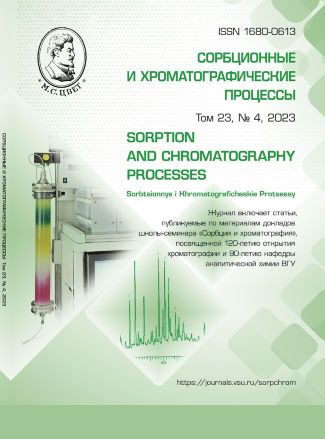Isolation and purification of isocitrate lyase by chromatographic meth-ods from the liver of rats under conditions of alloxan-induced diabetes
Abstract
The homogeneous preparation with isocitrate lyase activity was obtained from the peroxisomal fraction of rat hepatocytes using chromatographic methods. Male white inbred laboratory Wistar rats (Rattus norvegicus) were used as the object of the study. Experimental diabetes was induced by a single injection of a 5% alloxan solution. The development of diabetes was monitored by measuring blood glucose levels using a glucometer (SatellitePlus PKG-02.4). Blood sampling was carried out in the morning from the tail vein. On the 10th day of the experiment, laboratory animals were subjected to decapitation, previously euthanized with ether anaesthesia, to obtain liver tissue samples. For the isolation of a homogeneous preparation of isocitrate lyase (ICL, EC 4.1.3.1.), chromatographic methods were used. Purification included several stages: fractionation of the homogenate with ammonium sulphate, gel filtration on columns filled with Sephadex G-25 and ion exchange chromatography, which was the determining stage. The anion exchanger DEAE-Sephacel was used as a sorbent. This allowed to achieve a degree of purification of 12.12 for the first ICL isoform and 24.24 for the second ICL isoform. The specific activity for the first sample was 0.04 U/mg protein, and the yield was 26.3%. The specific activity value for the second form of ICL was 0.08 U/mg protein, and the yield was 47.4%. For elution from a column filled with DEAE-Sephacel was performed using step KCl gradient (60 mM – 200 mM). Identification of the resulting preparations was carried out spectrophotometrically, following the increase in the optical density, according to the Kornberg method (λ-324 nm). The presence of isoforms was determined by specific staining of the gel after PAGE electrophoresis. As a result of four-step purification, two isoforms with different from ICL (EC 4.1.3.1) from other sources electrophoretic mobility were obtained.
Downloads
References
Kulebjakin K.Ju., Akopjan Zh.A., Kochegura T.N., Pen'kov D.N. Mehanizmy transkripcionnogo kontrolja obmena gljukozy v pecheni. Saharnyj diabet. 2016; 19(3):190-19. (In Russ.)
Hanson R.W., Owen O.E., Gluconeo-genesis. Encyclopedia of Biological Chemistry. 2013: 381-386.
Lazarow P.B. Peroxisomes. Encyclo-pedia of cell Biology. 2016; 2: 48-272
Eprincev A.T. Glioksilatnyj cikl: uni-versal'nyj mehanizm adaptacii? / A.T. Eprincev, V.N. Popov, M.Ju. Shevchenko. M., IKC «Akademkniga», 2007, 228 p.
Popov V.N., Volvenkin S.V., Eprincev A.T., Igamberdiev A.U. Indukcija fermentov glioksilatnogo cikla v razlichnyh tkanjah go-lodajushhih krys. Izvestija RAN, serija biolog-icheskaja. 2000; 6: 663-667. (In Russ.)
Shevchenko M.Yu. Diss. Kand. Bio. Nauk. Voronezh, 2007, 24 p.
S. Song, Can the glyoxylate pathway contribute to fat-induced hepatic insulin re-sistance? Medical Hypotheses. 2000; 54: 739-747
Nikiforova V.J., Giesbertz P., Wiemer J. Glyoxylate, a new marker metabolite of type 2 diabetes. J. Diabetes Res. 2014; 2014: 1-10.
Lowry O.H., Rosebrough N.J., Farr A.L., Randall R.J. Protein measurement with the Folin phenol reagent. Journal Biological Chemistry. 1951; 193: 265-275.
Wilson K. and Walker J. Principles and Techniques of Biochemistry and Molecular Biology. 2010. 930 p.
Lenzen S., The mechanisms of alloxan- and streptozotocin-induced diabetes. Diabeto-logia. 2008; 51: 216-226.
Koptjaeva K.E., Muzhikjan A.A., Gushhin Ja.A., Beljaeva E.V., Makarova M.N., Makarov V.G. Metodika vskrytija i izvlechenija organov laboratornyh zhivotnyh (krysy). Laboratornye zhivotnye dlja nauchnyh issledovanij. 2018; 2: 71-92. (In Russ.)
Clore J.N., Glickman P.S., Helm S.T., Nestler J.E., Blackard W.G. Evidence for dual control mechanism regulating hepatic glucose output in nondiabetic men. Diabetes. 1991; 40: 1033-1040. (In Russ.)
Selemenev V.F., Hohlov V.Ju., Bobreshova O.V., Aristov I.V. Fiziko-himicheskie osnovy sorbcionnyh i membran-nyh metodov vydelenija i razdelenija ami-nokislot. M. Stelajt. 2002. 299 p







